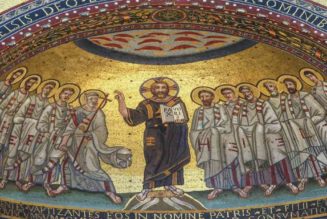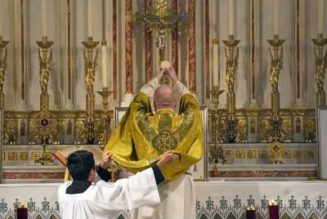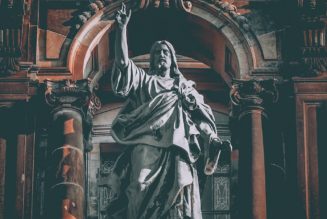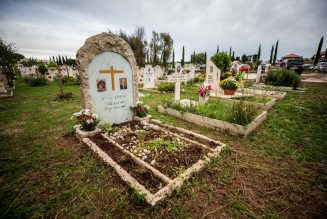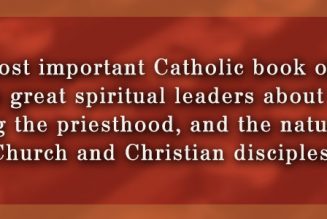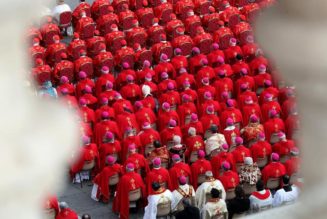By Dr. Jeff Mirus ( bio – articles – email ) | Feb 16, 2024
There has been a great deal of study of the Providential preparation for the Christian message in the Holy Land and in Europe, but not so much in other regions. Obviously, of course, the entire Old Testament is a kind of historical, cultural and spiritual chronicle of God’s preparation for the coming of the Messiah to His chosen people. Despite Christ’s widespread rejection by the Jews, there has been tremendous reflection on and analysis of the long period of preparation. This sacred history and subsequent reflections upon it by Christians around the world have led to a keen awareness of a long preparation by God so that, in the fullness of time, His personal disclosure in Christ might be accepted and lived by those who hear the Gospel.
Moreover, this same sort of Providential analysis has been very carefully and consistently applied to the decisive rise of Christianity in the Mediterranean region as a whole (where it has not necessarily persisted) and especially in Europe, both Western and Eastern. For centuries (perhaps until our own day), the preparation for the Gospel in the civilizations of ancient Greece and Rome has been a staple of European self-awareness. The bare bones of a very solid argument is that the European ground was prepared for a kind of fulfillment in Christ of the understanding of God and virtue developed by the best of the Greek philosophers and communicated over a wide geographical area through Roman conquest, organization and law. And of course this civilizational heritage was preserved and presided over in many ways by the Church herself.
In other words we can explain something of the explosive growth of Christianity in both European East and West, and then again in North America, in which the Indigenous populations were gradually displaced by immigrants from Europe. It may also be the case that we can find in the European colonization in Africa, along with a tremendous European and American missionary surge, a general explanation for the explosion of Catholicism and other forms of Christianity in Africa to this day. For despite the fact that Africa certainly had its own tribal cultures, it is generally agreed that the Western culture which was brought to Africa over the past three hundred years was at least widely regarded as a more highly developed and more powerful culture, in some ways akin to what the European tribes experienced under the influence of Rome. (But there may certainly be more specific particular African factors of which I am simply unaware.)
Missing narratives?
By contrast, it is hard to find any corresponding narrative which identifies clear reasons for the rapid growth of Christianity in what we call the East—in India and China and Japan, for example—for the simple reason that there has not been any explosive growth of the Church in these regions. But one other region that did, in fact, experience an explosive growth of Christianity, without simply displacing the original population, is the Americas south of the United States. Therefore, if we can see striking Providential preparations for the reception of the Gospel in Israel, in much of the Mediterranean world, and in both Eastern and Western Europe, and if we can somewhat explain the preparation for the dramatically widespread reception of Christ in nineteenth and twentieth-century Africa, which has continued into our own time, one wonders: Does there appear to have been any Providential preparation at all for the dramatic sixteenth-century explosion of Catholicism in the Americas south of the United States—in Mexico, in Central America and on into South America?
I ask because these regions were possessed of fairly sophisticated Mesoamerican cultures, and while the native peoples’ numbers were dramatically reduced both by the practice of human sacrifice and the later spread of European diseases, the native peoples were not simply displaced as they were further north. Moreover, while European—especially Spanish—missionaries came to these regions in large numbers and worked tirelessly to convert the local peoples, they were singularly unsuccessful in making large numbers of converts and had already grown seriously discouraged. In fact, immediately before the appearance of Our Lady of Guadalupe to Juan Diego, the European missionaries in this region were on the verge of quitting.
Therefore, we might well ask: What was it about Juan Diego’s alleged experience that persuaded millions upon millions of those living in this region very suddenly and rapidly to convert to Catholicism? What caused them to instantaneously embrace the Church in numbers that more than compensated (if such compensation is ever possible) for those lost to Protestantism as Europe fractured politically and religiously during the very same period of time? Why did this happen? What made it possible?
The short answer is simple: It was the gorgeous profusion of gloriously fresh flowers that spilled out of Juan Diego’s tilma, onto the floor of the episcopal office in Mexico City, in the middle of winter.
And therein lies another significant study of Providential preparation for the reception of the Gospel, a preparatory development every bit as significant as superior military power, Roman organization or Greek philosophy.
Guadalupe and the Flower World Prophecy
Despite the warring peoples in this region and the widespread practice of human sacrifice to win the favor of “the gods”, there was also a strong native element of monotheism in the belief in a “god-of-near-and-far” who was recognized as the one God over all others. There was also a strong oral (and sung) tradition, stretching back into the mists of time, describing a paradisiacal “flower world” of surpassing beauty and peace, represented by a compelling collection of song-poetry which told this story: A man was told to gather flowers from the mysterious flower world and give them to the nobles to usher in an era of beauty and peace, but despite dreaming that he had them, he could never quite find the flowers.
In addition, there was a flower symbolism that had been developed which was, among other things, used to mark the entrances to caves and even tunnels under the great pyramids built by these peoples, as such tunnels were regarded as potential paths to the flower world. In other words, deep in the psyche of many of the native peoples of these regions there had been dreams of a supreme being and a flower world paradise, which was also associated with human dignity, perfection and happiness—but which could never quite be found. At the core of this mythology was the story of the quest for the flower world and for the flowers, a quest which seems at times to be realized, but only in a dream-like way, such that the one involved in the quest loses his grasp on that world and wakes up both empty-handed and spiritually bereft.
This poetic tradition stretches back many hundreds and perhaps even thousands of years. It can be traced back into the Mayan civilization, which is thought to have its beginnings as early as 2,000 BC. Moreover, the very forms of expression traditionally used to refer to God, and the gods, and the paradise to which they held the key, made it difficult for the sixteenth-century Catholic missionaries to express Christianity clearly and effectively in ways that would not be confusing to the native peoples.
But when word spread of the miracle of the winter flowers cascading in dynamic profusion out of Juan Diego’s tilma in the offices of the bishop in Mexico City, everything suddenly and dramatically clicked into place. Juan Diego had fulfilled the Flower World prophecy. Millions of natives traveled long distances over the next few years to beg and plead for baptism, refusing to be denied despite a widespread lack of adequate instruction. The miraculous “Guadalupe Event” refers not just to Our Lady’s appearances to Juan Diego, to the healing of Juan Diego’s uncle, to the flowers, and to the image of Our Lady on Juan Diego’s tilma (complete with recognizable flower-world symbols), but to the stupendous rate of instantaneous conversion that followed.
A Remarkable Book
Joseph Julián Gonzáles and his wife, Monique González, both of whom have impressive accomplishments in the arts and in Catholic evangelization, began to learn about all these things in the 1990s and decided to do the extensive research necessary to explain the details of the belief in the Flower World and its connection with the appearance of Our Lady of Guadalupe. The result is a book published last year by Sophia Institute Press: Guadalupe and the Flower World Prophecy: How God Prepared the Americas for Conversion Before the Lady Appeared.
In about 280 pages of meticulous exploration and interpretation, the authors explore the conceptual keys that made the dramatic conversions possible; the ancient Mesoamerican myths of the Flower World; the most important features of the history and culture and philosophy of the pivotal Nahua people; the conceptual framework of the oral tradition of song about the Flower World; the Catholic missionary catechesis; the Guadalupe event; and the millions of Indigenous conversions. The book has been organized and developed so that, while it includes a tremendous amount of detail from the authors’ extensive research, it remains very easy to skim to pick up the main points of the thesis and the primary grounds for its validity. There is even an extensive bibliography. This is a carefully researched work; nothing about this remarkable account is merely imaginative or speculative.
In other words, now we can look at the nearly instantaneous conversion of the native peoples from the southwestern United States down into South America, we can wonder how this happened on such a scale, and we can see how God prepared the way. I am sure there is far more to learn here on earth, and infinitely more to learn in Heaven, but we now have some explanation for the explosion of Christianity in this world region which parallels what we know of the loving preparation by God for the Jews, for Christian Europe, and perhaps in at least some ways for Africa (though I suspect a more knowledgeable writer could probe beyond mere European influence). This account of the Flower World Prophecy is a vital and striking contribution. It reaffirms our conviction that God’s Providence is always at work: Even now God is still preparing the way for every people and for each of us to know Him in the end.
Joseph Julián Gonzáles & Monique González, Guadalupe and the Flower World Prophecy: How God Prepared the Americas for Conversion Before the Lady Appeared. Sophia Institute Press, 2023. 288pp. Paper: $18.95; Ebook: $9.99.
Sound Off! CatholicCulture.org supporters weigh in.
All comments are moderated. To lighten our editing burden, only current donors are allowed to Sound Off. If you are a current donor, log in to see the comment form; otherwise please support our work, and Sound Off!

There are no comments yet for this item.


